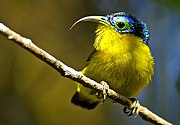| Neodrepanis | |
|---|---|

| |
| Common sunbird-asity (Neodrepanis coruscans) | |
| Scientific classification | |
| Domain: | Eukaryota |
| Kingdom: | Animalia |
| Phylum: | Chordata |
| Class: | Aves |
| Order: | Passeriformes |
| Family: | Philepittidae |
| Genus: | Neodrepanis Sharpe, 1875[1] |
| Type species | |
| Neodrepanis coruscans[2] Sharpe, 1875
| |
Neodrepanis is a bird genus in the family Philepittidae.
Etymology[edit]
Neodrepanis: Greek: νεος neos "new, strange"; δρεπανη drepanē, δρεπανης drepanēs "scimitar"[3]
Species[edit]
It contains the following species:
| Common name | Scientific name and subspecies | Range | Size and ecology | IUCN status and estimated population |
|---|---|---|---|---|
| Common sunbird-asity | Neodrepanis coruscans Sharpe, 1875 |
Madagascar | Size: Habitat: Diet: |
LC
|
| Yellow-bellied sunbird-asity | Neodrepanis hypoxantha Salomonsen, 1933 |
Madagascar | Size: Habitat: Diet: |
VU
|
References[edit]
- ^ Sharpe, R.B. (1875). "Contributions of the Ornithology of Madagascar". Proceedings of the Zoological Society of London. 43: 75. Retrieved 2018-02-13.
- ^ "Philepittidae". aviansystematics.org. The Trust for Avian Systematics. Retrieved 2023-07-24.
- ^ Jobling, J.A. (2017). "Key to Scientific Names in Ornithology". In del Hoyo, J.; Elliott, A.; Sargatal, J.; Christie, D.A.; de Juana, E. (eds.). Handbook of the Birds of the World Alive. Barcelona: Lynx Edicions.
External links[edit]
 Media related to Neodrepanis at Wikimedia Commons
Media related to Neodrepanis at Wikimedia Commons Data related to Neodrepanis at Wikispecies
Data related to Neodrepanis at Wikispecies



Well, that’s interesting to know that Psilotum nudum are known as whisk ferns. Psilotum nudum is the commoner species of the two. While the P. flaccidum is a rare species and is found in the tropical islands. Both the species are usually epiphytic in habit and grow upon tree ferns. These species may also be terrestrial and grow in humus or in the crevices of the rocks.
View the detailed Guide of Psilotum nudum: Detailed Study Of Psilotum Nudum (Whisk Fern), Classification, Anatomy, Reproduction